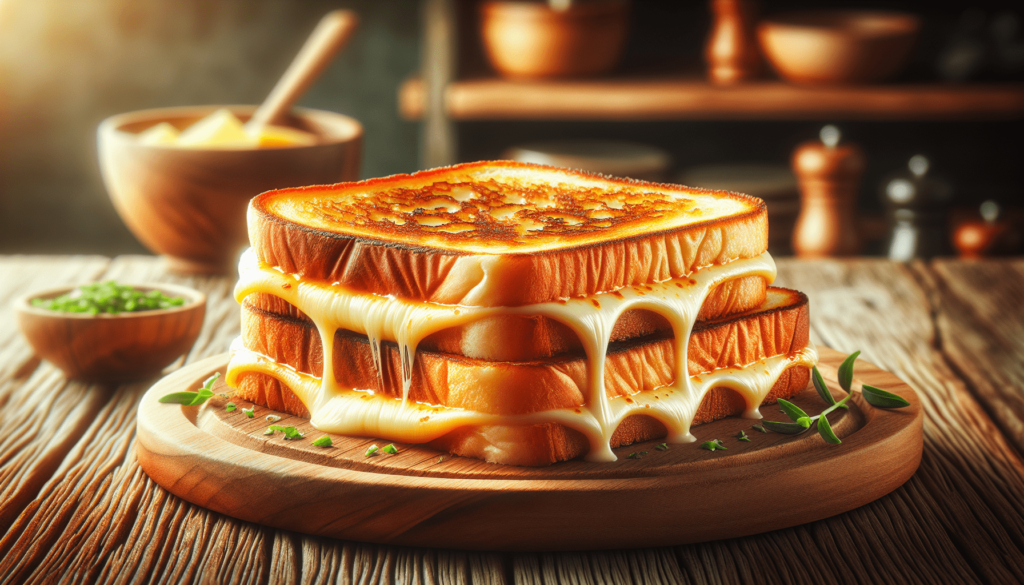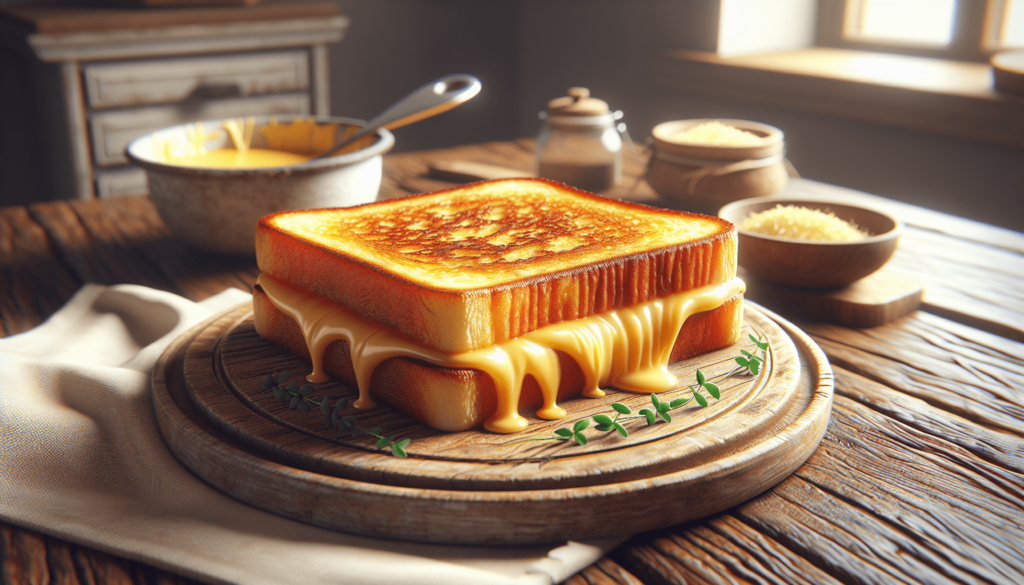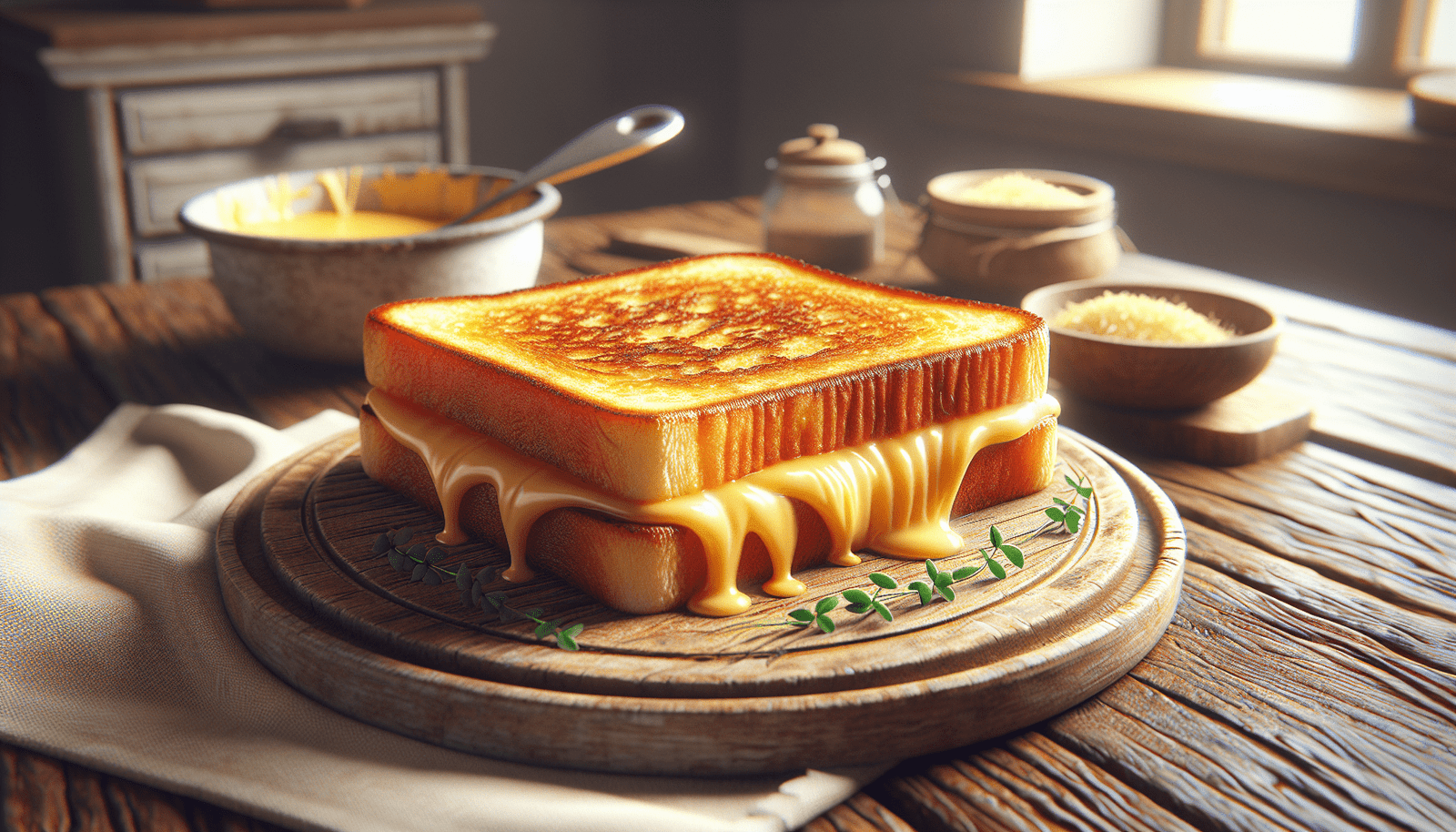Have you ever wondered what makes a perfect grilled cheese sandwich? The kind that melts in your mouth and brings a nostalgic warmth with every bite? You’re about to discover how to create a grilled cheese masterpiece, whether you’re a cooking novice or a seasoned chef. This isn’t just about putting cheese between two slices of bread and grilling it; it’s about transforming a simple dish into a work of art that tantalizes your taste buds.

Why Grilled Cheese?
Grilled cheese sandwiches are a universal comfort food. They’re simple, delicious, and can be made with ingredients you probably already have at home. The beauty of a grilled cheese is its versatility; you can tweak the recipe to suit your tastes or experiment with different ingredients. Learning how to make a perfect grilled cheese isn’t just a culinary skill—it’s an opportunity to explore and enjoy flavors.
Understanding the Basics
Before you start crafting your perfect grilled cheese, you need to understand the fundamental elements that make it so distinctive: bread, cheese, and butter. Each component plays a crucial role in determining the flavor, texture, and overall appeal of your sandwich.
Choosing the Right Bread
The bread serves as the vessel that holds your cheesy goodness together. While white bread is the traditional choice, branching out to sourdough, whole wheat, or even rye can add a new dimension to your sandwich. The key is to select bread that can hold up under the weight of melted cheese without becoming soggy. Here’s a quick comparison of bread types:
| Bread Type | Flavor Profile | Texture |
|---|---|---|
| White Bread | Mild and slightly sweet | Soft and fluffy |
| Sourdough | Tangy and rustic | Chewy with a crisp crust |
| Whole Wheat | Nutty and earthy | Dense and hearty |
| Rye | Strong and aromatic with a hint of sourness | Firm and slightly chewy |
Selecting the Cheese
Cheese is the star of the grilled cheese sandwich, and your choice can significantly impact the flavor. American cheese melts smoothly and offers a classic taste, while cheddar provides a sharper, more pronounced flavor. For a gourmet twist, consider using mozzarella, gouda, or even brie. Here’s what you need to know about common cheese options:
| Cheese Type | Melting Ability | Flavor Characteristics |
|---|---|---|
| American | Excellent | Creamy and mild |
| Cheddar | Good when aged appropriately | Sharp, bold, and slightly nutty |
| Mozzarella | Excellent | Creamy with a mild flavor |
| Gouda | Excellent | Buttery and caramel-like when aged |
| Brie | Good | Rich, creamy, and slightly sweet |
The Role of Butter
Butter not only adds flavor but also aids in creating that crispy golden-brown crust that makes grilled cheese irresistible. Unsalted butter lets you control the saltiness, while salted butter adds a hint of saltiness that complements the cheese. If you’re feeling adventurous, try using herbed butter for an added twist.
Crafting the Perfect Grilled Cheese
Now that you know the essential components, it’s time to put them together for a delicious grilled cheese sandwich. Here’s a step-by-step guide to help you through the process:
Ingredients You’ll Need
- 2 slices of your chosen bread
- 2–3 slices of cheese (or a handful if shredded)
- 2 tablespoons of butter
Method
-
Prepare Your Ingredients: Start by buttering one side of each slice of bread. Ensure the butter is evenly spread to guarantee an even crust. If you’re using multiple types of cheese, layer them on one unbuttered side of the bread.
-
Assemble the Sandwich: Place the slices of cheese between the bread, keeping the buttered sides on the outside. This ensures that the bread will toast and not stick to the pan.
-
Preheat Your Pan: Use a non-stick skillet or a well-seasoned cast-iron pan. Preheat over medium-low heat, ensuring that the pan reaches an even temperature to avoid burning the bread.
-
Cook the Sandwich: Place the sandwich in the hot pan. Cook each side for about 3-4 minutes until the cheese melts and the bread is golden brown. Adjust the heat if necessary to prevent the bread from burning.
-
Enjoy Your Masterpiece: Once done, remove from the pan and let it cool slightly on a cutting board. This resting period allows the cheese to set further, making it easier to cut and enjoy.
Adding Your Own Twist
A classic grilled cheese is delicious on its own, but sometimes, you might want to shake things up. Here are some ideas to add a personal twist to your sandwich:
Including Additional Ingredients
Enhance the flavor profile of your grilled cheese by adding extras like cooked bacon, tomato slices, or caramelized onions. These additions introduce new textures and flavors, turning your sandwich from simple to sensational.
Using Flavored Butters
Infusing your butter with garlic, herbs, or spices will add another layer of flavor to your grilled cheese. Consider mixing softened butter with garlic powder or finely chopped herbs before spreading it on the bread.
Experimenting with Dips
Sometimes, the flavor of the sandwich can be amplified with a delicious dipping sauce. Try pairing your grilled cheese with tomato soup for a classic combination, or go for something more unexpected like a balsamic glaze or spicy mustard.

Tips and Tricks for Perfection
Let’s take a look at some additional tips to ensure your grilled cheese turns out perfectly every time:
Keep it Low and Slow
Patience is key when it comes to a well-cooked grilled cheese. Too high a heat can burn the bread while leaving the cheese unmelted. Cooking it slowly over medium-low heat ensures the cheese melts evenly and the bread achieves the desired crispiness.
Don’t Overstuff
Although more cheese sounds better, overstuffing can lead to an uneven cook, with cheese spilling out of the sandwich. Aim for balance, using enough cheese to cover the bread without creating a mess.
Weigh it Down
To get that perfect, uniform crust, consider using a lightweight weight like a spatula to gently press down on the sandwich while it cooks. This helps the sandwich cook evenly and results in a crisper texture.
The Nutritional Aspect
While a grilled cheese is a delightful treat, it’s worth being mindful of its nutritional content. Here’s what you can typically expect from a classic grilled cheese sandwich:
| Nutrient | Average Amount per Serving | Key Points |
|---|---|---|
| Calories | 400–600 kcal | Varies based on the type of bread and cheese used. |
| Fat | 20–35 g | Cheese and butter contribute most of the fat content. |
| Saturated Fat | 10–20 g | Derived primarily from cheese and butter. |
| Protein | 12–20 g | Cheese is the main source of protein in the sandwich. |
| Carbohydrates | 30–40 g | Bread is the principal source of carbohydrates. |
| Sodium | 800–1200 mg | Pay attention to your cheese and butter choices. |
Remember, you can adjust these figures by selecting low-fat cheese or whole-grain bread. It’s all about creating a balance that fits your dietary needs.
Concluding Thoughts
Creating the perfect grilled cheese sandwich is both an art and a science. It allows you to indulge in creativity while refining your culinary skills. Whether you keep it classic or add your unique twist, making a grilled cheese is all about bringing joy and satisfaction to your dining experience. So, what are you waiting for? Gather your ingredients, fire up the stove, and let the magic of melting cheese transform your day!
Some of the links on this site are affiliate links, which means I may earn a small commission if you click on them and make a purchase, at no additional cost to you. As an Amazon Associate, I earn from qualifying purchases.



